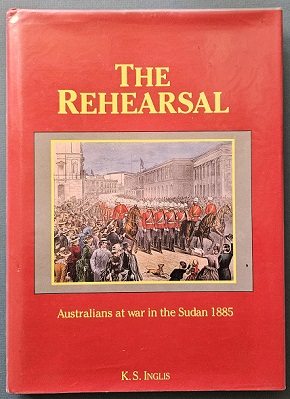Description
Title: The Rehearsal: Australians at War in the Sudan, 1885
Author: Inglis, K S
Condition: Very Good Plus – Some light foxing first few pages and last few pages.
Edition: 1st Edition
Publication Date: 1985
ISBN: 0727020811
Cover: Hard Cover with Dust Jacket – 176 pages
Comments: The unit history of the New South Wales Contingent to the Sudan in 1885.
The contingent, an infantry battalion of 522 men and 24 officers and an artillery battery of 212 men, was ready to sail on 3 March 1885. It left Sydney amid much public fanfare, generated in part by the holiday declared to farewell the troops; the send-off was described as the most festive occasion in the colony’s history. Support was not, however, universal, and many viewed the proceedings with indifference or even hostility. The nationalist Bulletin ridiculed the contingent both before and after its return. Meetings intended to launch a patriotic fund and endorse the government’s action were poorly attended in many working-class suburbs, and many of those who turned up voted against the fund. In some country centres there was a significant anti-war response, while miners in rural districts were said to be in “fierce opposition”.
The NSW contingent anchored at Suakin, Sudan’s Red Sea port, on 29 March 1885 and were attached to a brigade composed of Scots, Grenadiers and Coldstream Guards. Shortly after their arrival they marched as part of a large “square” formation – on this occasion made up of 10,000 men – for Tamai, a village some 30 kilometres inland. Although the march was marked only by minor skirmishing, the men saw something of the reality of war as they halted among the dead from a battle which had taken place eleven days before. Further minor skirmishing took place on the next day’s march, but the Australians, now at the rear of the square, sustained only three casualties, none fatal. The infantry reached Tamai, burned whatever huts were standing and returned to Suakin.
After Tamai, the greater part of the NSW contingent worked on the railway line which was being laid across the desert towards the inland town of Berber on the Nile, half-way between Suakin and Khartoum. Far from the excitement they had imagined, the Australians suffered mostly from the enforced idleness of guard duties. When a camel corps was raised, fifty men volunteered immediately. On 6 May they rode on a reconnaissance to Takdul, 28 kilometres from Suakin, again hoping for an encounter with the Sudanese, but the only action that day involved two newspaper correspondents who had accompanied the patrol before leaving the cameleers to file their stories in Suakin. They soon found themselves surrounded by enemy forces, and one was wounded as they fled. The camel corps made only one more sortie – on 15 May, to bury the bodies of men killed in fighting the previous March.
The artillery saw even less action than the infantry. They were posted to Handoub where, having no enemy close enough to engage, they drilled for a month. On 15 May they rejoined the camp at Suakin. Not having participated in any battles, Australian casualties were few: those who died fell to disease rather than enemy action. By May 1885 the British government had decided to abandon the campaign and left only a garrison in Suakin. The Australian contingent sailed for home on 17 May 1885.
The contingent arrived in Sydney on 19 June.




